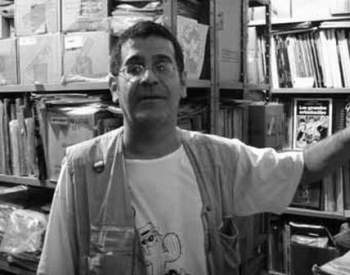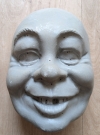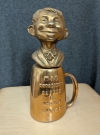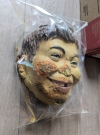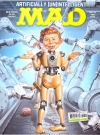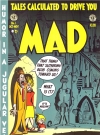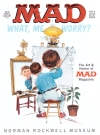Otacílio d‘Assunção was the editor of the Brazilian MAD Magazine for 34 years, since it started in 1974. The Brazilian MAD was published by 4 different publishers and he was there, in most issues of the first three MAD series.
by Bernd Engel
MADtrash.com:
When were you involved with Mad for the first time?
Ota:
Well, I started to read Mad when I first learnt to speak English, at 10 years of age or so. I used to buy the US edition and those Ballantine paperbacks on the newsstand, I loved them very much.
When I was 15 I started to work in a Brazilian comic publishing house where I learnt a lot of stuff that helped me later in my career. I also started to work as a cartoonist at a very early age.
In 1973 I quit my first job and started to look for another one elsewhere. By then the Vecchi publishing company was starting a comics line and they needed desperately someone to take care of it. I was introduced to the owner and he said “Well Mr. Otacilio, I ‘ll ask you some comics-related questions to see if you really know about comics?. And he asked questions like “What are the names of Donald Duck ‘s nephews? What is the name of the Phantom ‘s dog?”. I was scared thinking the guy was a jerk but answered the questions. After that “test” he shook my hand enthusiastically and said “Congratulations, you are the best candidate I have interviewed so far! The job ‘s yours!” And then I was suddenly the head of the comics department of Editora Vecchi. He told me a lot more publications would come. We started with some other magazines and he was secretly negotiating with Gaines and one day he said me: “I finished that secret negotiation I told you about earlier and now I can tell you what magazine it is. It ‘s Mad”. And I said “Cool!!!!” Mad was an instant success, it even had an emergency reprint, and it became the best-selling mag of Vecchi ‘s comics line and my job was safe. I still think any other nerd that had made that interview before me could have taken the job… But it happened that I was the right madman in the right place. I was very young back then. I was just 19 years old when all that started, and became famous as “the man that made Mad a success in Brazil”. Many other publishers had rejected publishing it because nobody really believed that an “american humor” magazine would work in Brasil, and it had been a failure in some other countries like Italy and France etc. I was lucky to find the ideal translator and assemble the staff for the local edition. We started with 100% US material then by the 2nd year we started to develop local material and sales increased.
MADtrash.com:
The rise of MAD Magazine in Brazil was very quick and it was very successful. Why did this Vecchi edition last only 9 years?
Ota:
Editora Vecchi went bankrupt but I was not responsible. The comics line sold very well. But a dispute among the Vecchi family members in the best mafia books style and a financial crisis in Brazil by the early 80s made them go bankrupt. The owner was fired by his own mother and the people that were in command didn ‘t like me and fired me as well. They put my secretary in my place!!!! Sales dropped very much. It was hard to convince the second publisher that it would work again. The first issue of the second series had a low print run and also had to be reprinted quickly.
MADtrash.com:
I guess that MAD magazine was a completely new experience for Brazilian comic and cartoon fans in the 1970′s? Was it very hard to sell the first issues in your country?
Ota:
The first Mad was released in mid-1974. Prior this Editora Vecchi had tried another comics publication named Eureka, made of comic strips in the same model as the Italian Linus, but it was a big failure. So Editora Vecchi was cautious and didn ‘t want to risk much. Nobody really knew if Mad would work here. So issue 1 had a 40.000 print run and was distributed as a test in Brazil ‘s biggest cities, Rio de Janeiro and Sao Paulo. Depending on the results, they would distribute the un-sold copies to the rest of the country or print more. When the first issue was on the newsstands, it became obvious it was selling well, so they printed an extra run of 30.000 more copies and sent them across the rest of the country. So Mad started in fact with 70,000 copies and that was the average for the first few issues. But sales started to rise. Issue 5 had that Nixon and Agnew cover for “The Sting” and sold a lot, so they raised the print run to 100,000 and it still increased with the subsequent cover about the Exorcist movie, which was a big hit here and everywhere. There were 100.000 or 120.000 copies sold of this issue was an excellent result for any magazine in Brazil. And it was increasing and building a steady audience all along.
MADtrash.com:
When did you decide to produce some local material?
Ota:
By issue 12 or 13 it became obvious we would have to produce some local material, or we would run out of pages. US Mad had 8 issues per year and ours had 12.
Besides that not everything from the US editon was “translatable”. So we decided to have at least 6 Brazilian pages in each edition but the question was “who would do it?”
MADtrash.com:
When I take a look in some old Vecchi MAD magazines, I see a lot of Brazilian artists and writers!
Ota:
A humor writer, Carlos Eduardo Novaes had a column in Jornal do Brasil (one of our biggest newspapers) and the President of Editora Vecchi approached him. Novaes brought along with him Vilmar Rodrigues, who was his illustrator in the newspaper. But the pieces they produced weren ‘t good at all. Novaes was good in plain text but not a good comic-book writer. So his contract wasn ‘t renewed (something similar had occurred in the early US Mad where they tried to hire well-known humourists like Stan Freberg and other ones but their pieces didn ‘t work either).
But Vilmar ‘s drawings were perfect for Mad. Vilmar was sort of a “Brazilian Jack Davis” or so and could do even caricatures or cartoons. We split the 6 local pages between other people and kept Vilmar. In fact, Vilmar became a contributor for life. He kept working until he died in the mid-90s.
MADtrash.com:
Vilmar can be compared to Jack Davis?! Please tell us more about him?
Ota:
Around 1976 Mad had reached its peak with print runs near 200.000 copies. By then the local pages were comprised of assorted cartoonists, just to fill the pages, but we also felt we should use them on covers. Vilmar was a complete artist, so he could draw covers, too. He was perfect and was in his late forties or early fifties by then, having had a reasonably successful career as a magazine or advertising illustrator behind him. And he was a very nice person. He just needed someone to write the text for him.
MADtrash.com:
After reading some of the Brazilian issues, I discovered that you acted very often as a writer. Did you also draw stuff for the Vecchi edition?
Ota:
In Brazil we had soap operas and they were very popular, so we decided to feature the major one in an upcoming cover, by issue 27. I wrote that piece and Vilmar illustrated it and the result was satisfactory. It was one of my few signed works in that series. I was a cartoonist by then but the publisher encouraged me not to draw my own pieces, telling me my style was too cartoonish and he was paying me for being the head of the comics department, not a cartoonist, etc. Besides I would not be able to collect any money if I published my cartoons and would be taking the place of another professional.
MADtrash.com:
So you were concentrating on being the editor of MAD?
Ota:
By then I was the head of a big comics line that included Casper, Dennis the Menace, Archie, some Bonelli western titles as Tex and Zagor, and Mad of course. An average of a dozen different comics each month and I didn ‘t have enough time to do both things ? to be creative and run the comics department, so I simply quit cartooning and dedicated myself to editorship, roughing sketches for the covers, and choosing the subjects and distributing the themes among the UGOI that we were forming.
MADtrash.com:
Was it difficult to hire new Brazilian artists and writers?
Ota:
People approached Mad because it was a solid publication and we didn ‘t have to go after anyone. They simply appeared with their portfolios and were picked. The average number of Brazilian pages grew from the initial 6 page slot to half of the magazine — that was mathematically the number of pages we would need to not run out of material.
Some nice guys like Jose Alberto appeared. Jose Alberto was the natural partner for Vilmar and wrote most of all pieces Vilmar drew. Claudio Almeida was an artist too, but he was good writing the text for Satires. He brought along with him a young fellow, Carlos Chagas, who drew very similar to Mort Drucker and did covers as good as Norman Mingo and was promoted to the cover spot. Months earlier Claudio and Chagas had produced an imitation of Mad for a competitor but it folded. Claudio approached me (we had known each other since I was in my teens working for the first publisher before joining Vecchi) bringing along Chagas, whom I didn ‘t know yet..
So we had Vilmar, Carlos Chagas and a lot of cartoonists like Luscar, Mariza, Guidacci and others, and some guys providing the text. The team was formed.
MADtrash.com:
Did your team members work for other projects? Did they ever get poached for other satire or comic magazines?
Ota:
Eventually Vecchis major competitor bought the rights for Cracked Magazine and launched its own Mad imitation, Pancada. They offered Carlos Chagas and Claudio more money and they left. Chagas was always sort of a mercenary guy. We met their first offer but they raised theirs, so they were away for a couple of years. When Pancada was cancelled they came back.
By then I ‘d had the luck to find another guy, Ramade, to replace Chagas. He was good at Drucker-like caricatures and filled the gap and of course he stayed when Chagas came back.
MADtrash.com:
I bet Vecchi earned lots of money with the MAD license, the circulation was fantastic for a foreign edition. However, did Vecchi publish additional comic titles? Were you involved in those projects?
Ota:
So we are more or less around 1978 and Mad was walking by itself. I had a large staff by then, and by that time Editora Vecchi had started to publish its own Brazilian comics, some horror and western titles. By the early 80s, we produced an incredible amount of 400-plus comics pages (including the 20 of Mad) and I was the head of all that, with something like 25 or 26 years. It was hard to find writers for the horror stories that did stuff in the line I wanted — most characters should die, not escape in the end of the stories. That worked a lot. I wrote around 2/3 of the scripts in my spare time under pen-names. For me it was very easy to write stories. I was capable of writing 50 comics script pages a day if needed. I also freelanced for the competitors writing Brazilian scripts for characters like Beetle Bailey that had most of its pages produced here.
MADtrash.com:
Back to MAD, what was the most successful or most popular department in your opinion in the Vecchi MAD?
Ota:
It must be said that one of the most popular sections was the Letters Page, which was COMPLETELY different from the US edition. The US edition usually had letter commenting on back issues features and a light-funny answer. Ours was far more aggressive. There was a war between the staff and the readers, and even between staffers. All them insulted each other. Most readers wrote letters telling us something like “Your magazine is shit. The paper is crap and can ‘t be even used as toilet paper. You are all idiots.” We published those and insulted the readers back, “If you read Mad it ‘s because you ‘re an idiot and have no right to complain. Go to hell.” They wrote back even more aggressively. Some of the readers started to have quarrels between themselves. And the staffers had quarrels between themselves although they were fictional staff. We had an editorial about the contents. But then a guy that worked as assistant editor had the idea to publish an “Redatorial” insulting the Editor saying the Editor was a jerk and he, the copywriter, did all the heavy work. Eventually we added stuff like a “Publishorial” — a letter from the publisher warning we would be all fired, if we kept fighting in front of the readers and insulting them. And in fact “we” were fired all along. The fictional staff of “The Office” changed all the time. There was always a new writer on the staff and each of them was zanier than the last. There were intrigues involving them, for instance the Writer ‘s sister was hired because she was having an affair with the Editor. Even the janitor had a column, a “Janitorial” or such.
That was done because the letters were always the same “your magazine is like toilet paper” stuff– readers imitated each other. So to avoid repeating each letters page all the time we simply changed the “staff” all the time. So our letters section jumped from 2 to 4 or even 6 pages each issue — and the readers loved it, despite it was written by the same staffers who created different characters all time. Sometimes it was a robot answering the Letters Page or a gay man, or a lesbo, or even the daughter of the banker that lent money to the publisher and asked him to hire his daughter to return the favor. That formula worked very well all the time in the subsequent series. Most were written by Jose Ealberto under my direction. I called him and said: “Ok this month the guy who answers the letters was arrested so they will be answered by the only staffer available, the Janitor”. and he wrote as if he was the “janitor”. “This month we had a strike and no letters will be answered, so we ‘ll simply print two blank pages with a note attached apologizing to the readers and promising next month we ‘ll replace all strikers that have just been fired”. “This month the answerer was hired by a competitor and replaced by a robot”. Stuff like that.
That formula worked for decades! Some of the readers competed between themselves to see which one had more letterers answered. That was really fun.
MADtrash.com:
The first edition of the Brazilian MAD run until 1983. What was the reason for the end of the Vecchi era in this year?
Ota:
From 1974 to 1981 Mad was under my direction and the main UGOI of real and fictional contributors was formed. In 1981, as I said, a family crisis involving the Vecchi Family started and the family owners split; Brazil had its first big crisis in the economy in years and magazines suffered from that. General sales went down and they were in debt because they decided to build a new printing plant and had a lot of debt in dollars with the bank. There was a major devaluation of the Brazilian currency and they suddenly had their debt in dollars stupidly increased. Also, the publisher fired his own nephews because they were ruining everything and then they complained to their mothers, they called the Grandmother that fired her own son and a different staff of Vecchis took over. I was fired in that process. So the last year of Mad at Vecchi was not under my direction. And the people that took over didn ‘t really knew how to run a humor magazine. they thought “Okay we have the phone numbers of every contributor, we ‘ll just tell them that Ota was fired and ask them to submit their pieces and that ‘s okay”. They didn ‘t realize that what was needed was a maestro to command an orchestra. And some of the contributors started to submit again pieces that had been rejected by me months before!
The last year of Mad in Vecchi was not good at all. The company was suffering from money losses, started to skip payments and people left. I was lucky to have been fired. Vecchi went into bankruptcy within a year.
That was a pity, because they had hundreds of employees. The comics were still profitable, but most of the magazines were not cheap to do and required expensive professionals. All that was lost in a short space of time.
For the record Mad Brasil went from an average of 100,000 copies sold per issue to a mere 30,000 copies in a short space of a little less of a year. Part of that was because it wasn ‘t funny anymore, but also because with the economic crisis. Readers had less money to spend on comics and such things.
MADtrash.com:
You stayed away from Mad for 2 1/2 years. What did you do meanwhile?
Ota:
Well that was terrible because I was suddenly unemployed. I had a good salary by Brazilian standards and it was very difficult to find a job as an editor elsewhere. Mainly because of the economic crisis. Nobody was hiring or willing to pay me the same. So I went on free-lancing, but my income was drastically reduced. And worst of all, people that flattered me before simply turned their backs on me. When I realized that were no jobs as an editor available, I took a decision: “back to the drawing board”. I ‘d stayed away from my own cartoons and comics during the Vecchi period because of the lack of time and now I had all the time of the world. I started to sell cartoons to crossword and sex magazines, and even found a space at O Pasquim, another humor publication, a political tabloid. Pasquim was not so popular as it was in the late sixties when it was a real hit, but was still being published. I also wrote lots of horror stories for a small publisher and lots of Brazilian Beetle Baileys, but there wasn ‘t much demand. All the publications paid very little and those were hard times. Eventually I found a part-time job at Ebal, the same publisher I worked with before Vecchi. They were very strong in the 50s and 60s, but had declined in the mid-70s and weren ‘t publishing as many comics as before. They had lost some good contracts such as Marvel Comics who had gone to other publishers. But they had started a magazine called Cinemin, about movies, and needed an assistant editor for it. I also contributed with some mad-like pages for some sex magazines! I wrote sex/porno satires and Carlos Chagas illustrated them. Everything was forbidden when Brazil was under a dictatorship in the mid-60s and 70s, but in the early 80s the government allowed naked girl magazines and suddenly there were a bunch of them. But the sex-magazine craze didn ‘t last very long.
I spent the whole year of 1982 freelancing for those small publications.
In 1983 I kept doing all that and spent half of my time writing a book about Carlos Zefiro. Carlos Zefiro was a pen-name and nobody knew who he was. He wrote and drew hundreds of comics similar to the Tijuana Bibles during the late 50s and sixties and those comics were sold by underground dealers. I found lots of those books and started to write a book about his work. The project was originally for the same company that published O Pasquim, but I had a disagreement with them and sold the book to Editora Record, the same publisher that would eventually publish Mad the following year. I had a good relationship with its owners. Record was not only a big book publisher but also they started as agents for foreign comics and in the times of Editora Vecchi I ‘d bought dozens of comics from them. They represented Harvey, Western Printing and others. I called Sergio Machado, the owner, and talked about the Zefiro book and he bought it on the spot. The book sold very well by Brazilian standards. Regular books started with a 3.000 run but the first edition of my book had 5.000 copies and was reprinted shortly after. Then Sergio Machado approached me telling he was trying to deal with Gaines about the publication of the Mad pocket books. But there was a problem: Gaines wanted to sell the rights of the books to the same publisher that would publish the Mad magazine. Vecchi had already folded by then. The magazine publishers wanted the magazine but not the book, and Sergio wanted the books but had no means to publish the magazine — his publishing house only published books and they had no know-how. I told him: “don ‘t worry about that. I have all the know-how you need. Just put the money on it and I ‘ll make Mad work”. So he signed with Gaines for both books and mag and it started all over again! The only condition I imposed was that now the magazine would have 3 pages of my “Ota” work in each edition. He gladly agreed.
MADtrash.com:
It was July 1984 when the first Mad of the new series hit the newstands. What was the response?
Ota:
Record did a good job, even invested in television commercials showing the magazine was back. We decided to re-start the numbering from #1 again and assume it was a new series. But the distributor (the same as Vecchi ‘s) was reluctant. They said that in its last issues Mad was declining and advised Machado not to print so many copies. So we did the same old trick again. 40.000 copies were printed as a test and distributed in Rio and Sao Paulo. Depending on the figures more copies would be printed. The phenomenon repeated! Initial check-ups showed it was a hit and they quickly printed 30 or 35.000 more copies for the rest of the country.
MADtrash.com:
And did you use the same UGOI?
Ota:
Sure! When the deal with Record was done I approached them all. “Hi, Carlos Chagas, it ‘s Ota again and Mad will be back via another publisher. I ‘d like you draw the covers and the main satires”. I wrote the pieces he illustrated. I also approached Vilmar, Jose Alberto and the others. Everything was back and since everybody had matured, the contents were even better. So we were all happy again, and since it was a hit again it was not difficult to get a good budget. Everything was back, including the “fake staffers” in the letters section. And since Brazil was turning back to a democracy again the fake staffers decided to do an election to chose the new “Editor”. We printed the voting papers in the magazine and asked the readers to vote. The candidates were people that really worked at Editora Record with fake names. The copy machine guy also was a candidate. Even a dog was a candidate. The winner of the election was the copy machine guy, but the election was considered null and void, because “we discovered the copy guy used the office machine to copy the votes and votely massively for himself (xerox copies were accepted if the readers didn ‘t want to destroy the magazines). Because of the fraud, the winner was Rex the Dog, that “edited” Mad for a few issues, then ran away and Mafia people took over. The “inside story of the Office” was becoming so complicated that one year later we simulated a plane crash and all the fake staffers were dead, when they took a plane to go to a comics convention or something. The Letters Department of that issue was a big obituary with pics and short bios of all of them. I myself posed as a model for two or three of the fakes. Of course in the following issues we started all over again with a new bunch of fake staffers.
MADtrash.com:
How were the sales?
Ota:
Very good!
Circulation was rising again and we soon reached 150.000 copies printed like in the old times. A new generation of readers were forming and they liked everything… except my own work. I received lots of letters asking to “fire that stupid Ota”. My style was too “sketchy” and was in contrast with fine illustrations by Chagas ‘ or Vilmar ‘s. But that situation reversed when the first Ota Report was published.
MADtrash.com:
The Ota Report became one of the main attracions of the magazine. How that was possible?
Ota:
It was an accident. I don ‘t remember exactly what happened, but we had planned a cover and main article and it had to be dropped, I don ‘t remember if the televison show was canecelled or if Carlos Chagas was ill and could not do the job that month, or even if the US Mad material was delayed. But suddenly we had no cover and a 6-page blank slot in the magazine and we were just a few days away from the deadline. So I had to think fast. The only one capable to do a piece in such a short time was myself. I had published two years or so before the first “Ota Report” in another humor magaine in the freelance days: “The Hota Report on Sex”, a pun on the famous Hite Report that was a best-seller by then. So I think. Hummm. I can do an “Ota Report” again. Drugs would be a nice theme. But I Still needed a cover and someone that could to it fast. I called Enio Torrezan desperately. We were friends and he was starting his carreer (Enio later became a respected animator and made an international career — he was involved recently in the Sponge Bob cartoons). I asked him if he could do a cover in two days and he said yes! I sketched it quickly: simply Alfred as a drug dealer. But inside his coat were not the usual drugs. “Drug” in Portuguese applies also for “nasty stuff” so he was selling pictures of politicians and Mad Magazine itself. I did the whole Ota Report on Drugs also on that focus. And then the deadlines were accomplished. By then I didn ‘t expect that issue to be a big hit, only have average sales. But when the sales record arrived I was really surprised. It had sold more than 90 percent! And that was very very good, because the average sales were 70 percent. The Print run was raised in subsequent issues and everyone was happy, including the readers. Instead of the usual “fire Ota” letters I started to receive more and more letters asking for new Ota Reports! Of course I repeated the formula as soon as possible with “The Ota Report on Sex” (in reality a remake of the old one) and “Ota Report on AIDS” and it became a regular feature, appearing every two or three issues since then. And they all worked.
MADtrash.com:
Were there new UGOIs in that new series?
Ota:
Sure! Mad paid very well and the office doors were always open to anyone with good ideas and good artwork. Lots of people submitted pieces, and there was space for everyone. Most of the contributors sold a few pieces and disappeared, but the “real UGOIs” stayed. By the mid-80s Ed and Nivaldo appeared and they became regulars. Ed became very popular. He did one-page pieces in the Don Martin style and also lots and lots of regular articles. He was capable of writing and drawing very well and he was really funny.
Nivaldo did cartoons in the “Aragones style”. We had a lack of Aragones by then because he didn ‘t publish “A Mad Look At…” in every US issue and also the US edition had by then just 8 issues a year and we had 12. And we also published a bi-monthly Mad Special with new and old material that was selling very well too. So we needed something similar to “The Mad Look” to fill the gaps. Eventually we needed “fake spy vs. spys” to fill the gaps and he was good at imitating the Prohias style too, and ghost-writers provided the gags. Other good newcomers were Tiburcio, who had a refined style, and Pupuca (that guy had a completely different style and was funny too. He almost always drew his characters without arms). Of course there were many other UGOIs and it ‘s difficult to remember all of them. Some old contributors from the Vecchi series like Flavio and Xalberto were regulars, also. Carlos Chagas did a lot of covers but they also were done by another painter, Rogerio W.S. Also, another “Mort Drucker-alike”, Tako X also did the satires. And by that time Claudio Almeida ‘s son, Andre, became an adult and also an artist. Father and son contributed with some pieces: Claudio wrote and Andre drew them. Since the Record series was the longest-running one (17 years) a new generation of UGOIs was also formed in the 90s. Talented young people like Fernando Miller (now a respected animator) and Marcelo Martinez (now a famous designer) appeared submitting their artwork. Marcelo was also good scripting for others. A new generation of young writers like P. C. Barreto and Xandelon also appeared. All them were on their early twenties when they started.
MADtrash.com:
We ‘ve been told that sales declined by the 90s. Why was that?
Ota:
Well, until 1990 Mad had an average 100.000 print run. But then the economic plans of the government spoiled everything. Brazil was under hyper-inflation in the late 80s. If you see the cover prices of that period sometimes they double each issue and every other year the currency was changed. Then President Fernando Collor took drastic measures to stop inflation. It ‘s too complicated to explain what happened, but one of the economical plans was to simply withdraw most of the money in circulation. People had money in the bank but could not use it. So for a short period of time everyone was broke! So circulation decreased from one issue to the next, from 100.000 to 70.000 and never slowed down. By the mid-90s circulation was around 40.000 and Mad was not so profitable anymore. Everyone on the staff was at their best. But sales kept dropping. Not everyone knows that, but Record seriously considered cancelling Mad in 1995.
MADtrash.com:
How was that?
Ota:
The comics imprint was not working anymore. Besides Mad Record also tried other stuff — even the E.C. Comics horror stories. And Love and Rockets and Bonelli western stuff. They all folded by the mid-90s. So it was not profitable for them to keep a comics department with a lot of employees. Another publisher was interested and Sergio Machado was negotiating with them to transfer the Mad contracts. The problem was that publisher was far away and near a slum. We went to a meeting and I said to the owner. “Listen, I don ‘t mind working with you but I don ‘t want to travel an hour everyday and come near that slum. It ‘s too dangerous. I propose you pay me a fee and I ‘ll deliver you a package every month”. The guy didn ‘t like the idea but Sergio Machado ‘s eyes gleamed. In the way back to the Record office he said. “Hey Ota that is a nice idea. I like to work with you, but simply can ‘t afford keeping a comics department. So if you want we can do that stuff you proposed to the other guy. You deliver me the package and I ‘ll pay you a fee. That was great for me, because I would earn more and could work at home. So by the end of 1995 on, I worked for Record as an independent packager — all the staffers and contributors would work directly for me. I inherited everything in the office and took boxes and boxes with the mad files home. The deal was so good I was able to raise everybody ‘s salaries and we were all happy for a few more years.
MADtrash.com:
So the Record series is divided in two. When did that start?
Ota:
Around issue 118. We had some losses by that time. Three important contributors passed away in a short period of time. Vilmar was the oldest of us – he was in his early seventies by then and died of cirrhosis. He didn ‘t drink a single drop of alchool in his whole life but died of cirrhosis. That was really sad. By the same time Jose Alberto had a fatal heart attack and died at only 56. And the letterer, Valim, died of cancer. He was almost as old as Vilmar. But by them we had already started to use computer fonts.
We had 5 more happy years and the new-blood UGOIs like Miller and Martinez were good aquisitions. But then, by 2000, sales were so bad that Sergio Machado didn ‘t renew his contract with DC. Another small publisher bought Mad but the deal was not so good.
Interview by Bernd Engel in Summer 2010 for MADtrash.com
Special thanks to Simon Wilson for the review
…and of course a big thanks to OtacÃlio d ‘Assunção for his spare time and detailed answers!!!


